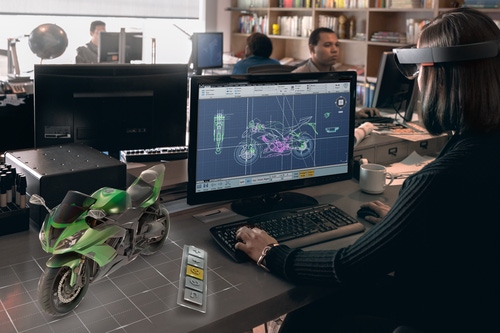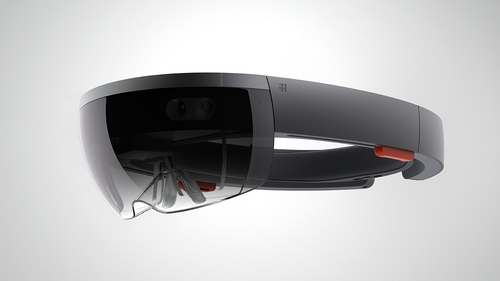January 26, 2015


Microsoft unveiled more than a new operating system at its Windows 10 event. The company is hoping its HoloLens augmented reality headset will flip our relationship with the technology around us on its head. The company's vision in one word? Holograms. Imagine interacting with technology not through keyboards or touch screens but via interactive holograms layered over the real world.
“We immerse ourselves in technology. But what if we could take technology and bring it into our world?” Alex Kipman, a technical fellow in the Operating System Group at Microsoft said. In recent years Kipman has emerged as a sort of mad scientists among the Microsoft ranks. He's best known as the creator of the Kinect motion controller for the Xbox.
“We're dreaming about holograms mixing into your world,” Kipman said at the event. Windows 10 is going to come with a built in holographic API that will allow developers to create their own interactive holograms through platform Microsoft has dubbed "Window's Holographic."
Key to this new platform is the HoloLens. On the surface it looks like just another virtual reality headset, but it's already building up quite a bit of industry buzz. Kipman was quick to emphasize that the HoloLens is something beyond virtual reality. The goal isn't to put us in virtual environments, it's to put technology into real environments. While it sounds like an apples to apples comparison, the difference can be significant.
The HoloLens is a see-through headset that looks like a pair of grandma sunglasses but is packed with some heavy-duty technology. The onboard camera has a 120 x 120-degree field of vision, and the hardware boasts 18 sensors capable of detecting location, gestures, orientation, movement, and sound. “HoloLens has spatial sound. So we can hear holograms even when they're behind us,” Kipman said. “The sensors capture information about what we're doing and the environment we're in.” Using gesture control similar to the Kinect, Holosync is able to let wearers control what they're seeing with only their hands and no additional controller.
The device processes terabytes of information in real time with an onboard CPU and GPU coupled with a new type of processor Kipman called a Holographic Processing Unit (HPU). “The HPU gives us the ability to understand where you're looking, to understand your gestures, to understand your voice. It gives us the ability to spatially map the entire world around us.” And it does all of this without wires, external markers, or cameras, and without a phone or PC connection.

HoloLens is able to layer holograms onto the real world with depth and distance using an optical illusion in effect. Each lens has three layers of glass—red, blue, and green— with microthin layers that diffract light. When light (projected by the device's “light engine”) hits the lens it bounces around these layers and input from HoloLens' various sensors tricks the wearer's eye into perceiving the image as floating out in the real world rather than just projected on the lens.
Microsoft envisions a variety of applications for “the first fully untethered holographic computer” from manufacturing and design, to medical, and, of course, entertainment. Kipman invited developers already working with the Oculus Rift, Magic Leap, and Google Glass to give the holographic API a try. He demonstrated how easy it could be with a demo of HoloStudio, software designed to let users create their own interactive holograms (and even 3D print them).
So far reviews from those lucky enough to have tried the HoloLens hands on have been glowing overall. Some reviewers have complained about comfort, but Microsoft has assured that the final iteration of the HoloLens will be lighter and more ergonomic than the demo version on display at the Windows 10 event.
The biggest question mark of course is can Microsoft succeed in this grand endeavor? Upon its release the Oculus Rift was hailed as the final realization of the virtual reality technology we've been promised since the '80s, but the device hasn't seen a mass consumer release. And, on the developer front, it hasn't really penetrated beyond its target market, video games. Though a $1 billion investment from Facebook could bode well for the Rift's future beyond gaming.
What Microsoft is attempting is nothing new. Companies have experimented with similar augmented reality concepts with Google Glass, but with the company recently shuttering sales of the device it brings into question just how viable Google sees the wearable headset platform as being. However, Microsoft seems to be aiming their new device at more utilitarian applications rather than plotting the always on, all the time approach that Glass took. HoloLens may succeed in marketing itself purely as a device or peripheral and not a lifestyle accessory.
The Windows 10 OS is expected to launch in late 2015. Microsoft didn't announce a release date for the HoloLens but Kipman said it would come sometime in the lifetime of Windows 10. Hopefully we won't be seeing Windows 11 too soon then.
Watch Microsoft's proof-of-concept for the HoloLens:
Design engineers and professionals, the West Coast’s most important design, innovation, and manufacturing event, Pacific Design & Manufacturing, is taking place in Anaheim, Feb. 10-12, 2015. A Design News event, Pacific Design & Manufacturing is your chance to meet qualified suppliers, get hands-on access to the latest technologies, be informed from a world-class conference program, and expand your network. (You might even meet a Design News editor.) Learn more about Pacific Design & Manufacturing here.
Chris Wiltz is the Managing Editor of Design News.
About the Author(s)
You May Also Like



